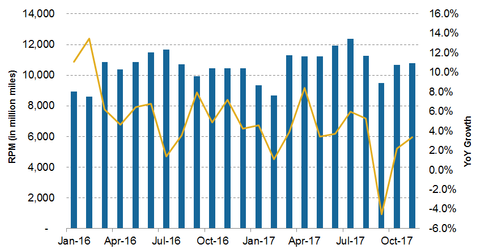Is Southwest’s Demand Growth Enough to Fill Its Added Capacity?
In November 2017, Southwest Airlines’ (LUV) traffic grew 3.4% year-over-year (or YoY). This growth was higher than its capacity growth of 2.5% YoY in the same month.
Nov. 20 2020, Updated 2:57 p.m. ET

Traffic growth lags capacity
In November 2017, Southwest Airlines’ (LUV) traffic grew 3.4% year-over-year (or YoY). This growth was higher than its capacity growth of 2.5% YoY in the same month.
Southwest Airlines’ traffic growth has lagged its capacity growth for four months in 2017, and it has exceeded its capacity growth for four months, while it’s matched its capacity growth in the remaining two months.
Peer comparison
Year-to-date (or YTD) in May 2017, Southwest Airlines’ traffic recorded growth of 3.4% YoY, slightly lower than the 3.7% YoY capacity growth Southwest saw in the same period.
Regional players JetBlue Airways (JBLU) and Spirit Airlines (SAVE) also saw their demand growth lagging their respective capacity growth YTD in November. Legacy player United Continental’s (UAL) demand growth also lagged its capacity growth in the period. For details, read United Continental’s Traffic: Head-to-Head with Capacity Growth.
In contrast, Delta Air Lines’ (DAL) traffic growth has exceeded its capacity growth so far in 2017. For details, read Demand at Delta Is Now Growing Fast.
Outlook
According to the IATA (International Air Transport Association), passenger travel demand is expected to continue its growth trend given the improving global economic outlook. Travel demand is known to closely track the growth in the global economy.
In the next article, we’ll discuss Southwest Airlines’ capacity utilization. Investors can gain exposure to Southwest Airlines by investing in the First Trust Long/Short Equity ETF (FTLS), which holds 1.3% of its portfolio in LUV.
